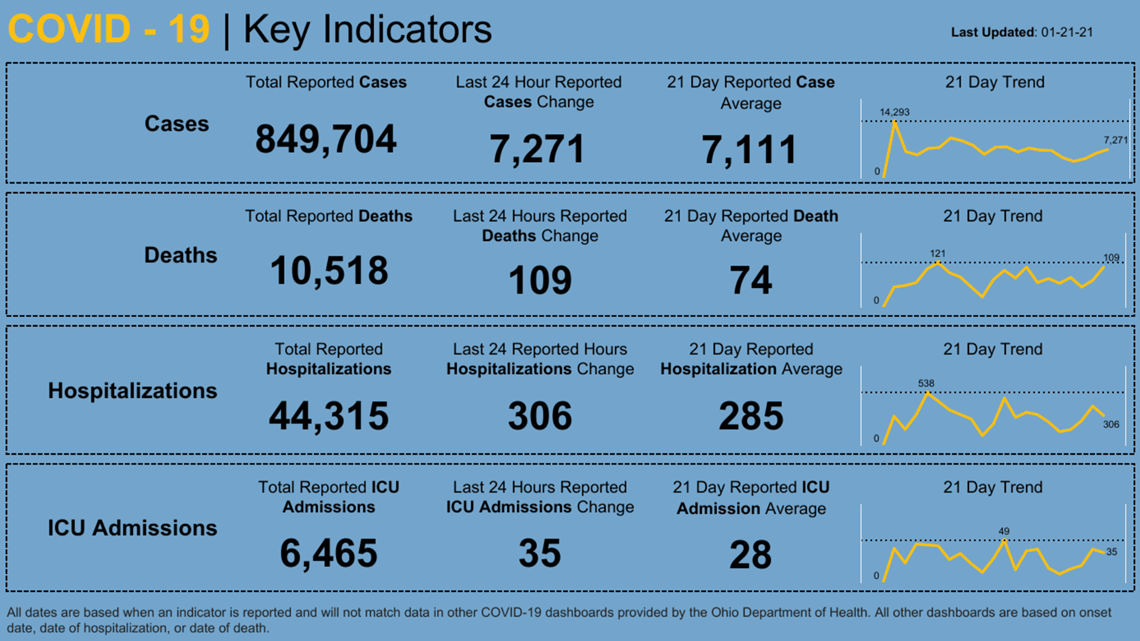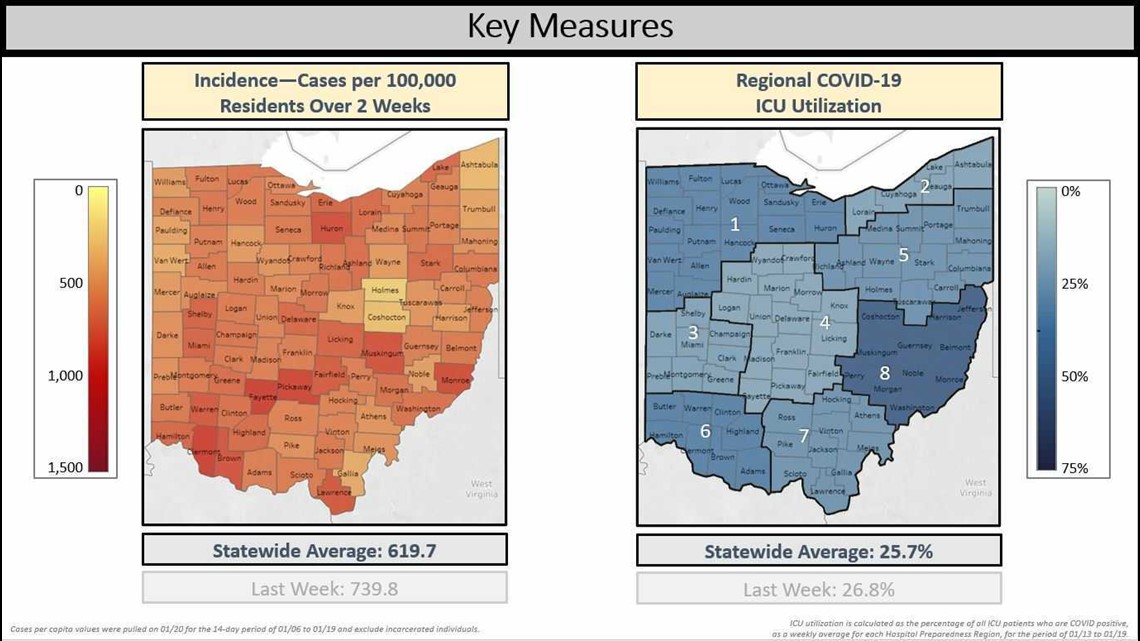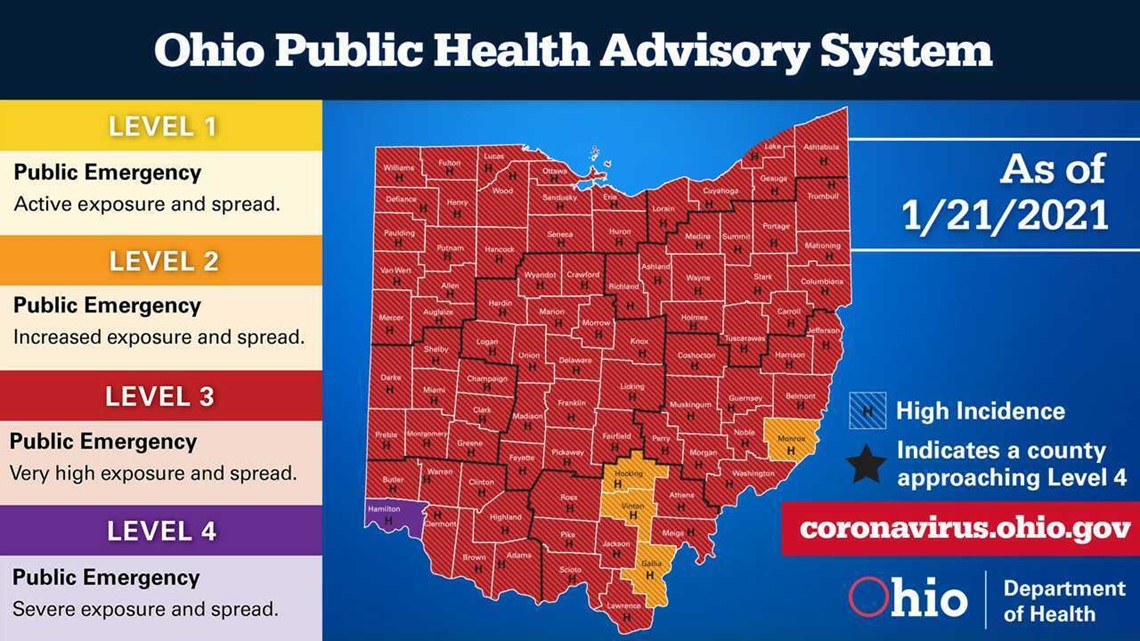COLUMBUS, Ohio — The state's coronavirus curfew will be extended, Ohio Gov. Mike DeWine said Thursday, although no end date was immediately released.
The current curfew goes from 10 p.m. until 5 a.m. each night and was created in an effort to slow down unnecessary travel. It was set to expire on Saturday, Jan. 23.
DeWine said one of the factors playing into his decision to extend the curfew is the discovery of a new strain of coronavirus in the state, that has been noted to transmit more easily. He said his team is trying to balance letting people make a living and doing what they please, with keeping the spread of the virus under control.
"As governor, I have to try to keep this virus down. At the same time, we're getting this vaccine out just as quickly... as quickly as we can," DeWine said.
The governor noted that the next step would likely be loosening those restrictions, with the curfew start time eventually moving to 11 p.m. but, "we're not there yet," he said.
As a reminder, there are a number of exceptions to the curfew, including:
- Going to or from work
- Leaving for an emergency or to receive medical care.
- Getting groceries
- Going to the pharmacy
- Picking up food
Drive-thrus, takeout options and delivery have also been able to continue during the curfew period, however, indoor dining is still required to close at 10 p.m.
The comments were made during the questions portion of his coronavirus press conference on Thursday.
Here's a breakdown of what else was discussed:
VACCINE
Next week, on Jan. 25, Ohioans 75 years old and above, will join the current eligible group to receive a coronavirus vaccine in the state under Phase 1B.
The state expects the same amount of the vaccine next week as it did this week, which was roughly 100,000 doses.
The governor said distribution will likely take some time, as there are an estimated 2.2 million people who fall under the criteria laid out in Phase 1B.
AT-HOME TESTS
DeWine announced Thursday a new partnership involving Abbott and eMed to provide rapid COVID-19 tests for home use.
Ohio will purchase at least 2 million, at-home BinaxNow COVID-19 rapid antigen tests that can be self-administered, providing results in about 15 minutes.
Through an agreement with eMed to provide telehealth services, an individual who uses one of these tests can be guided live by video. Users will get the results in minutes, without having to visit a testing spot.
The $50 million investment uses CARES Act funding in the hopes of making testing more broadly available.
DeWine said that local health departments will be given broad guidelines, allowing them some flexibility to decide who needs those tests and when. Some communities have mentioned using them for first responders, and others have discussed their use in schools, for example.
KEY INDICATORS
On Thursday, the Ohio Department of Health reported:
- 7,271 new cases of coronavirus, compared to the 21-day average of 7,111
- 109 new coronavirus-related deaths, compared to the 21-day average of 74
- 306 new hospitalizations, compared to the 21-day average of 285
- 35 new ICU admissions, compared to the 21-day average of 28


CASES PER 100,000 PEOPLE
As of Thursday, all Ohio counties were still well above the Centers for Disease Control and Prevention (CDC) threshold of 100 cases per 100,000 people. The state's county with the lowest number, Holmes, still had more than two times that limit.


Out of any 200 Ohioans, at least one has tested positive for COVID-19 during the past two weeks, DeWine said.
Additionally, the state is still reporting that more than one out of four patients are COVID-19 positive in its ICUs.


Public Health Advisory Map
No Ohio county's status worsened Thursday. There were 83 counties at Level 3 (Red), four counties at Level 2 (Orange) and one county still at Level 4 (Purple).


SCHOOLS
School staff are expected to begin receiving vaccines on Feb. 1. DeWine announced previously that only schools that signed a letter of intent, promising to return to at least some form of in-person learning by March 1 would receive those doses.
As the Feb. date approaches, more schools have made the shift back to in-person learning, DeWine said.
He reported that as of Thursday, out of all of Ohio's students, around 42% were back in-person five days per week, 33% were learning under a hybrid model and nearly 24% were fully remote.
COMPLETE PRESS CONFERENCE
TUESDAY
Tuesday marked the first day of Phase 1B in the state's COVID-19 vaccine distribution plan, with those 80 or older first on the list.
A 101-year-old woman in Jamestown, Ohio received her first dose live during Tuesday's press conference, saying "it didn't hurt." Another senior at the facility, a 98-year-old man followed suit. He said, "I just felt a little 'ting.'"
In Wood County, Deputy Health Commissioner Amy Jones helped vaccinate a woman in her own home. It was part of an effort, she said, to help seniors with limited options for transportation.
The goal is to continue vaccinating the state's oldest citizens this week, while lowering the age group by five years each week, making those 75 and older on deck for Jan. 25.
For those who qualify and still need to schedule an appointment, there is a tool on the state's coronavirus website, allowing Ohioans to search for providers by county and zip code. It also provides information on how to contact each provider and schedule an appointment. Appointments must be made through the individual provider.
As Phase 1B kicked off, Phase 1A neared completion Tuesday, DeWine said.
Most hospitals have finished vaccinating staff, and all 930 state nursing homes will have received at least the first dose by the end of the day Tuesday. Some nursing homes have even began distribution of the vaccine's second dose.
DeWine acknowledged that the process for Phase 1B will take some more time, however. There are an estimated 2.2 million Ohioans in the Phase 1B group overall, and the state is still dealing with a scarcity of the vaccine.
For perspective, the state received 100,000 doses this week, but there are 425,000 people in the 80+ age range alone.
Vaccine shipments are expected stay level for a few weeks, DeWine said. Although the number of doses may increase a little bit, the state isn't expected to see a major jump until March, when the Johnson and Johnson one-dose option is likely to be approved.
Ohio Department of Health (ODH) Chief Medical Officer Dr. Bruce Vanderhoff reminded Ohioans that these shots are not currently pediatric vacines. In accordance with CDC, the Pfizer vaccine is only available to those 16 and older, and the Moderna option is available for Ohioans 18 or older. Both vaccines are two-shot regiments, and people should recieve their second shot at the specified interval; for Pfizer that comes three weeks after the first dose, and four weeks after for Moderna.
Here is the current schedule for Phase 1B distribution:
- Jan. 19: Ohioans 80 and older
- Jan. 25: Ohioans 75 and older; those with severe congenital, developmental, or early-onset medical disorders and who have a developmental or intellectual disability
- Feb. 1: Ohioans 70 and older; school staff - Feb. 1
- Feb. 8: Ohioans 65 and older
- Feb. 15: Those with severe congenital, developmental, or early-onset medical disorders and do not have a developmental or intellectual disability
SEVERE CONGENITAL, DEVELOPMENTAL OR EARLY-ONSET MEDICAL DISORDERS
Tuesday brought more clarity for a population of the Phase 1B plan that, until now, have largely been ignored.
DeWine announced that starting next week, vaccinations will be open for those Ohioans with severe congenital, developmental, or early-onset medical disorders that make them particularly vulnerable and who have a developmental or intellectual disability.
For those with an intellectual or developmental disability and one of these conditions, their local county developmental disabilities board will reach out to them to help coordinate receipt of the vaccination, DeWine said.
People who have any of those conditions and do not have an intellectual or developmental disability will be eligible to receive the vaccine starting Feb. 15.
The state lists the following conditions as falling under the Phase 1B criteria:
- Cerebral palsy
- Spina bifida
- Congenital heart disease
- Type 1 diabetes
- Inherited metabolic disorders
- Severe neurological disorders, including epilepsy
- Severe genetic disorders, including Down syndrome, fragile X syndrome, Prader-Willi syndrome, and Turner syndrome
- Severe lung disease, including cystic fibrosis and severe asthma
- Sickle cell anemia
- Alpha and beta thalassemia.
Vanderhoff explained that this list was created by first referencing the CDC's list of pediatric medical conditions and focusing on those that persist into young adulthood and have strong evidence of risk.
SCHOOLS
One of the three goals of the state's vaccination effort is to get students back in the classroom in some capacity by March, which is one reason why school staff have been included in this next phase of distribution.
In order to receive those doses, however, DeWine has required that district leaders sign a letter of intent, promising to get their students learning in person - at least on a hybrid schedule - by that March 1 deadline.
As of Tuesday, 96% of the state's schools committed to that goal.
For those districts and other schools that have signed on, the state has designated them a local Educational Service Center as a working partner. These centers are expected to communicate with districts this week in an effort to week put together final plans.
DeWine explained that school districts will be choosing either a retail pharmacy partner, secured by the state, or an existing local partnership to administer their vaccines. These will be closed clinics, not directly competing with those trying to get into hospitals or retail pharmacies.
KEY INDICATORS
On Tuesday, ODH reported the following:
- 4,989 new cases compared to the 21-day average of 7,309
- 55 new death compared to the 21-day average of 77
- 254 new hospitalizations compared to the 21-day average of 284
- 20 new ICU admissions compared to the 21-day average of 28


COVID-19 VARIANT
As reports continue to come in about a new strain of coronavirus being found in the U.K. and now in the U.S., including in Ohio, Vanderhoff explained that SARS-CoV-2 is, in fact, changing through a natural process of mutation to become more contagious.
While Vanderhoff said these changes are generally expected, what is noteworthy, is the fact that the changes both internationally and in Ohio look strikingly alike.
Despite their similarities, a study conducted by the Ohio State University found that the mutation in Ohio had a genetic signature typical for the United States - not the U.K., suggesting the mutation arose here and wasn't imported.
Experience suggests, he said, that these more contagious strains will become more dominant in just a few weeks.
So, what can we do?
Vanderhoff explained that Ohioans should continue with the safety protocols that have been in place for months: wear a mask, stay apart, avoid crowds, provide good ventilation in indoor settings, and practice regular hand-washing.
Despite their mutations, these strains still can't get from person to person without droplet or micro-droplet spread.
Vanderhoff said health officials remain confident that the current COVID-19 vaccines will cover these strains. However, he said their appearances underline the importance of our current safety measures and encouraged Ohioans who are able to receive the vaccine when it is their time.
DEATH OF OFFICER BRANDON STALKER
Though not related to the pandemic, DeWine took a moment to honor the life of the late TPD officer Brandon Stalker.
Stalker was shot in the line of duty Monday during a standoff in central Toledo.
The governor ordered that flags in Lucas County and across Columbus be lowered to half-staff until sunset on the day of Stalker's funeral.

